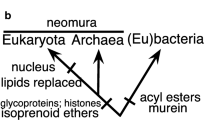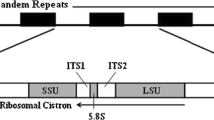Summary
Partial nucleotide sequences for the 5S and 5.8S rRNAs from the dinoflagellateCrypthecodinium cohnii have been determined, using a rapid chemical sequencing method, for the purpose of studying dinoflagellate phylogeny. The 5S RNA sequence shows the most homology (75%) with the 5S sequences of higher animals and the least homology (< 60%) with prokaryotic sequences. In addition, it lacks certain residues which are highly conserved in prokaryotic molecules but are generally missing in eukaryotes. These findings suggest a distant relationship between dinoflagellates and the prokaryotes. Using two different sequence alignments and several different methods for selecting an optimum phylogenetic tree for a collection of 5S sequences including higher plants and animals, fungi, and bacteria in addition to theC. cohnii sequence, the dinoflagellate lineage was joined to the tree at the point of the plant-animal divergence, well above the branching point of the fungi. This result is of interest because it implies that the well-documented absence in dinoflagellates of histones and the typical nucleosomal subunit structure of eukaryotic chromatin is the result of secondary loss. and not anindication of an extremely primitive state, as was previously suggested. Computer simulations of 5S RNA evolution have been carried out in order to demonstrate that the above-mentioned phylogenetic placement is not likely to be the result of random sequence convergence.
We have also constructed a phylogeny for 5.8S RNA sequences in which plants, animals, fungi and the dinoflagellates are again represented. While the order of branching on this tree is the same as in the 5S tree for the organisms represented, because it lacks prokaryotes, the 5.8S tree cannot be considered a strong independent confirmation of the 5S result. Moreover, 5.8S RNA appears to have experienced very different rates of evolution in different lineages indicating that it may not be the best indicator of evolutionary relationships.
We have also considered the existing biological data regarding dinoflagellate evolution in relation to our molecular phylogenetic evidence.
Similar content being viewed by others
References
Azad AA (1979) Nucleic Acids Res 7:1913–1929
Cachon J, Cachon M, Salvano P (1979) Arch Protistenk 122:43–54
Cachon J, Cachon M (1977) Chromosoma 60:237–251
Cavalier-Smith T (1975) Nature 256:463–468
Cavalier-Smith T (1978) J Cell Sci 34:247–278
Crick FHC (1966) J Mol Biol 19:548–555
Dayhoff MO (1978) Atlas of Protein Sequence and Structure, vol 5, suppl 3, Nation Biomed Res Foundation, Washington, DC
Demoulin V (1975) Bot Rev 40:315–345
Dobzhansky T, Ayala FJ, Stebbins GL, Valentine JW (1977) Evolution ch 12, WH Freeman & Co, San Francisco
Dodge JD (1965) Excerpta Med Int Congr Ser 19:339
Dodge JD (1973) The Fine Structure of Algal Cells, ch 3, Academic Press, New York
Duffus JH, Penman CS, Webb NWG (1973) Experientia 29:632–633
Erdmann VA (1976) Prog Nucleic Acids Res Mol Biol 18:45–90
Erdmann VA (1980) Nucleic Acids Res 8:r31-r47
Fitch WM (1976) J Mol Evol 8:13–40
Fitch WM, Margoliash E (1967) Science 155:279–284
Fox GE, Woese CR (1975) Nature 256:505–507
Giesbrecht P (1962) Zentralbl Bakteriol Parasitenk Infektionskr Hyg Abl 1: Orig 196:516–519
Hamkalo BA, Rattner JB (1977) Chromosoma 60:39–47
Heath BI (1978) Nuclear Division in the Fungi. Academic Press, New York, p 89
Herr W, Noller HE (1975) FEBS Lett 53:248–252
Hinnebusch AG, Klotz LC, Immergut E, Loeblich AR III (1980) Biochemistry 19:1744–1754
Hinnen A, Hicks JB, Fink GR (1978) Proc Natl Acad Sci USA 75:1929–1933
Hollande A (1974) Protistologica 10:413–451
Holmquist R (1972) J Mol Evol 1:115–133
Horgen PA, Silver JC (1978) Ann Rev Microbiol 32:249–284
Hori H, Osawa S (1979) Proc Natl Acad Sci USA 76:381–385
Klotz LC, Komar N, Blanken RL, Mitchell RM (1979) Proc Natl Acad Sci USA 76:4516–4520
Kubai DF (1973) J Cell Sci 13:511–552
Kubai D, Ris H (1969) J Cell Biol 40:508–528
Larue B, Cedergren RJ, Sankoff D, Grosjean H (1979) J Mol Evol 14:287–300
Leedale GF (1968) In: Buetow DE (ed) The Nucleus in Euglena, ch 5, Academic Press, New York
Loeblich AR Jr (1974) Taxon 23:277–290
Loeblich AR III (1976) J Protozool 23:13–28
McDonald K (1972) J Phycol 8:156–166
Marco Y, Rochaix JD (1980) Mol Gen Genet 177:715–723
Maxam AM, Gilbert W (1980) Methods Enzymol 65:521–522
Maxwell IH, Maxwell F, Hahn WE (1977) Nucleic Acids Res 4:241–246
Nazar RN, Sitz TO, Busch T (1975) J Biol Chem 250:8591–8597
Nishikawa K, Takemura S (1974) J Biochem 76:935–947
Noller HF, Garrett RA (1979) J Mol Biol 132:621–636
Oakley BR, Dodge JD (1974) J Cell Biol 63:322–325
Pavlakis GN, Jordan BR, Wurst RM, Vournakis JN (1979) Nucleic Acids Res 8:2213–2238
Peattie D (1979) Proc Natl Acad Sci USA 76:1760–1764
Philippsen P, Thomas M, Kramer RA, Davis RW (1978) J Mol Biol 123:387–404
Ragan MA, Chapman DJ (1978) A Biochemical Phylogeny of the Protists, Academic Press, New York
Ris H, Kubai DF (1974) J Cell Biol 60:702–720
Rizzo PJ, Burghardt RC (1980) Chromosoma 76:91–99
Rizzo PJ, Nooden LD (1974) Biochim Biophys Acta 349:402–444
Nishikawa K, Takemura S (1974) J Biochem 76:935–947
Rubin GM (1975) In: Prescott DM (ed) Methods in Cell Biology vol 12. Academic Press, New York, p 45
Sagan L (1967) J Theor Biol 14:225–274
Sankoff D, Cedergren RJ, Lapalme G (1976) J Mol Evol 7:133–149
Schwartz RM, Dayhoff MO (1978) In: Dayhoff MO (ed) Atlas of Protein Sequence and Structure, vol 5, suppl 3, Nation Biomed Res Foundation, Washington DC
Soyer MO (1971) Chromosoma 33:70–114
Soyer MO (1972) Chromosoma 39:419–441
Tanaka Y, Dyer TA, Brownlee GG (1980) Nucleic Acids Res 8:1259–1272
Tartof KD (1975) Ann Rev Genet 9:355–385
Taylor FJR (1976) J Protozool 23:28–40
Tonnesen T, Engberg J, Leick V (1976) Eur J Biochem 63:399–407
Tuttle RD, Loeblich AR III (1975) Phycologia 14:1–8
Vigne R, Jordan BR (1977) J Mol Evol 10:77–86
Werner-Schlenzka H, Werner E, Kroger H (1978) Comp Biochem Physiol 61B:587–591
Wigler M, Sweet R, Sim GK, Wold B, Pellicer A, Lacy E, Maniatis T, Silverstein S, Axel R (1979) Cell 16:777–785
Wilson AC, Carlson SS, White TJ (1977) Ann Rev Biochem 46:573–639
Author information
Authors and Affiliations
Rights and permissions
About this article
Cite this article
Hinnebusch, A.G., Klotz, L.C., Blanken, R.L. et al. An evaluation of the phylogenetic position of the dinoflagellateCrypthecodinium cohnii based on 5S rRNA characterization. J Mol Evol 17, 334–347 (1981). https://doi.org/10.1007/BF01734355
Received:
Revised:
Issue Date:
DOI: https://doi.org/10.1007/BF01734355




